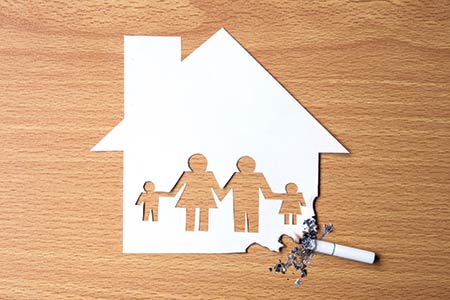Second-hand smoke inhaled by non-smokers and children in particular causes numerous health problems including frequent and severe asthma attacks, respiratory and ear infections, and sudden infant death syndrome – Dr. Gita Mathai

The fatal health hazards of smoking are graphically displayed on cigarette packs and ads on television and in public places warn people of the dire consequences of lighting up. Yet, over the past decade, India has added over 35 million smokers with the total population of smokers estimated at 110 million nationally.
Initially it was believed that only direct smokers suffered bad health. But recent research has proved that second-hand smoke inhaled by non-smokers and children in particular, causes numerous health problems including frequent and severe asthma attacks, respiratory and ear infections, and sudden infant death syndrome. Cigarette smoke is classified into ‘first, second and third-hand smoke’.
First-hand smoke
First-hand smoke directly affects the person who lights up. Even if it doesn’t actually kill, it shortens the life of a male by about 12 years and of women by 11 years. Cigarettes release carbon monoxide when burned. This replaces oxygen in the blood which negatively impacts the functioning of all bodily organs.
Carbon monoxide apart, 7,000 other toxic chemicals are released by the paper and tobacco combination. Of them, 70 are provenly carcinogenic while many others are poisonous. Nicotine — the main ingredient of tobacco — induces addiction and dependency. Nicotine released from cigarettes is absorbed into the blood stream, and increases dopamine (the pleasure chemical) supply in the brain. Therefore smoking becomes an enjoyable activity, and gradually an addiction.
Tobacco inhalation affects every part of the body. Hair turns prematurely grey, the brain degenerates faster, eyes develop cataract, the skin wrinkles and ages faster, teeth develop cavities, and mouths release bad breath. It can also adversely affect the heart, causing multiple blocks and high blood pressure. In the gastrointestinal tract, it causes ulcers and indigestion. Fertility is also impacted. Men who smoke often have a lower sperm count and women are less likely to get pregnant. An extreme consequence of compulsive smoking is emphysema and COPD (chronic obstructive pulmonary disease), which makes breathing difficult and painful.
Second-hand smoke
Second-hand smoke released by tobacco smokers into the environment causes passive smoking. It affects all people who live with smokers. Over the years, family members develop the same ailments as active smokers. In homes where ventilation is poor or rooms are kept closed because of rain, winter or air-conditioning, the smoke is re-circulated and inhaled by others, especially children.
Common health disorders reported by passive smokers are allergic wheezing, sneezing and ear infections. Most children complain of watery nasal discharge and coughs. Every few weeks, clear mucoid discharge gets secondarily infected by bacteria. This induces fever. Antibiotics, nebulizers, inhalers and bronchodilators make minimum impact until the source of their afflictions — cigarette smoke — is removed from the environment. Another adverse effect of  constant nose block is that children lose their appetite resulting in weight loss.
constant nose block is that children lose their appetite resulting in weight loss.
Third-hand smoke
“I only smoke outdoors. This doesn’t affect anyone’s health,” say some smokers piously. They are unaware of latest research studies highlighting the dangers of third-hand smoke, the outcome of particles of nicotine and other chemicals released from cigarettes that suffuses indoor furniture, furnishings and walls. Other incidental in house pollutants combine with these chemicals, forming poisonous compounds. These toxins are continuously released into the air and are also transferred to children who tend to touch furniture and other surfaces and put their hands in their mouths and noses.
Once the third hand smoke suffuses furniture, curtains and linen, it cannot be removed by airing out rooms using exhaust fans or air-conditioning. It can only be removed by washing.
Quitting benefits
Once parent(s) kick the habit, the damaging effects of first, second and third-hand tobacco smoke wear off rapidly. Within five years the risk of suffering strokes and heart attacks reduces to that of non-smokers. Within 15 years, there is no difference in life expectancy or mortality.
But quitting is difficult. Active smokers are likely to experience craving, irritability, insomnia, increased appetite, constipation, depression and persistent cough. But these symptoms are temporary and will wear off. Some compulsive smokers find that using nicotine patches or gum reduces craving. Physicians can help with medication for depression, insomnia, cough and constipation. The great danger is that children who grow in smokers’ households subconsciously crave the smell and high of tobacco. They may also exhibit withdrawal symptoms.
Yet the plain, irrefutable truth that all responsible parents need to acknowledge is that in the interest of the health and well-being of every family and children in particular, this deadly habit needs to be snuffed out.
(Dr. Gita Mathai is a Vellore-based paediatrician and author of Staying Healthy in Modern India)























